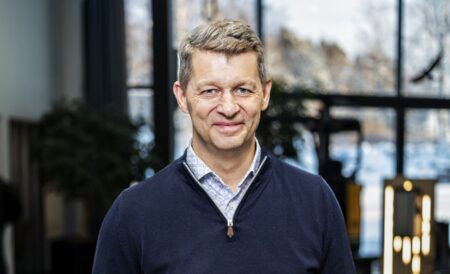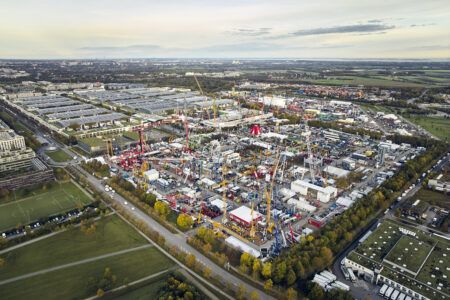Jack Roper, iVT International
In France, an electric revolution is afoot. Volvo CE, which demonstrated an all-electric quarrying ecosystem in Sweden, developed the EX2 prototype electric excavator with French government sponsorship. The EX2’s success confirmed Volvo CE’s long-term vision for electromobility and it now stands poised to launch the first machines in a compact electric production range: the L25 Electric wheel loader and ECR25 Electric excavator, based on the EX2, which debuted at the 2019 Chelsea Flower Show.
Meanwhile, homegrown French manufacturer Mecalac are field-testing the e12, an electric edit of the versatile 9-tonne 12MTX articulated wheeled excavator. Both firms are grappling to optimise the machine architectures and battery solutions, often pragmatically tailored to machine application. Both are involved in complex calculations around ownership and net environmental costs, each with shifting variables. From 2020, both will bring machines to a zero-emissions urban market advancing now in Paris.
“The EX2 represents our highest degree of electrification,” says Volvo CE electromobility expert Ahcène Nedjimi. “In mid-2020, we will launch our electric machines and end diesel-engine development on those models, making every new compact project electric in order to create this new market.”
Based in Lyon, Nedjimi has presented the EX2 prototype to French President Emmanuel Macron and Swedish PM Stefan Löfven, and collaborates with electromobility leaders across Volvo’s Bus, Trucks and Penta brands in a Group-wide electrification strategy. The 2018 Electric Site project saw Volvo CE and partners electrify a full quarrying operation, achieving 98% emissions-reduction with a medley of vehicle architectures. “We replaced elephants – large articulated haulers – with ants,” he says. “15-ton HX2 autonomous, battery-powered haulers. We used LX1 hybrid wheel loaders and a cable-powered EX1 excavator.”
Radical reimagining
Electrification compels engineers to imagine the radical machine forms which may optimise a new type of worksite power. “The HX2 needed no driver, and removing the cab allowed us to achieve more with the design,” says Nedjimi. HX2s visited the charger autonomously for one minute of every ten-minute shift, recovering sufficient energy for another cycle. “Those batteries provide high short-term power, but greater autonomy requires different technology.”
Hybrid LX1 wheel loaders featured wheel-mounted electric motors instead of a conventional driveline, creating new machine space. For static crushing duties, the 70-tonne EX1 used cable-power, albeit a less feasible solution for mobile machines, spinning and reaching on complex construction sites. But for all electric’s transfiguring potential, commercial ECR25 and L25 Electrics maintain the familiar layout of predecessor diesels. “Operators must learn to adapt to new machines,” says Nedjimi. “Electrification will create new behaviours, but you must take small steps for market acceptance.”
While Volvo CE conjured with seminal, mission-specific architectures, Mecalac took their existing 12MTX architecture as an apt template for electrification. “The 12MTX is both powerful and extremely compact,” says Mecalac’s Head of Design and Product Management, Patrick Brehmer. “It’s our technology-leading machine and perfectly fitted for electrification.” Billed as the world’s first articulated excavator, the 12MTX has a 9700kg operating weight but a turning width of just 2710mm. It has two hydraulic circuits and a rear-mounted 85kW engine separated from its compact turret, its two sections connected via swivel-joints. Divorcing hydraulics from engine mass provides space to accommodate bulky battery packs.
“The best available technology gives us 1.5m3 of batteries,” says Brehmer. “In a classical excavator that would mean losing compactness and becoming more static. But our architecture allows us to add 1.5m3 without compromising urban jobsite manoeuvrability.”
But this liberating architecture means the versatile 12MTX works as an excavator, loader, telehandler and tool-carrier, spending just 25% of work-time idling, compared to 70% for normal excavators. High utilisation creates a need for high energy autonomy.
Battery density
“This multi-purpose machine never stops,” says Brehmer. “It digs, loads, handles pallets. When working, they’re always in motion. People fear switching to electric because of autonomy.” 12MTX telematics data suggested the e12 required sufficient energy for 8-hours autonomy. Its first prototype provided 146KWh using Lithium Iron Phosphate batteries, but its successor achieves 160KWh with an alternative technology, not yet announced. “We wanted to ensure it was the best technology,” says Brehmer. “Power density and safety are key inputs, together with lifetime. A mobile machine still needs 80% battery capacity after 8 years. It’s about volume, price, integration, assembly and maintaining machine balance and dynamic behaviour.”
“Battery density is continuously improving by 5-10% annually and we anticipate disruptive technologies like solid-state batteries, which are safer and could offer twice the energy-density of conventional batteries in ten years’ time,” Nedjimi predicts. ‘‘The European Battery Alliance will receive over $4 billion in EU funding. Since most battery technology now comes from Asia, Europe must close the readiness gap.” Charging mechanisms must also be tailored to application. “The ECR25 Electric’s on-board charger plugs into a domestic socket,” he says. “It’s limited by how much current it pulls from the grid, so it’s suitable for overnight charging.” This is fine for doing four hours’ utility work, but not for gruelling process applications. A one-hour fast-charger for intensive eight-hour work means you can recuperate capacity during lunch.”
Machine efficiency
Electrification is more than a routine power-transplant. Machine efficiency is key to its feasibility and every detail must be re-examined to accrue marginal economies of space and energy. “Once we had the global architecture and the energy request, everything was redesigned,” says Brehmer. “We redesigned the rear undercarriage to integrate the energy and motors. We did huge work on the turret and analysed every possible optimisation of electro-hydraulic pilot-controls. We made the air-conditioning more efficient with separated batteries and electrically-driven fans.”
Mecalac is ideally positioned for this undertaking since it manufactures most components in-house. “The story began when we made our own swivel-joints to carry hydraulics, electricity and water,” Brehmer explains. “High industrial and technological integration allows us to redesign each detail.” The machine must marshal every ounce and sinew in service of its power-source.
Once accomplished, electrification’s labour yields abundant operational dividends and gives working a whole new feel. “Obviously there are less fumes, but also no more vibration in the cab,” says Nedjimi. “Digging feels more pleasant and the electric motor is more responsive. Full power is instantaneous, and torque is maintained with no rpm-drop when you load the engine.”
But the efficiency of electric motors is arguably their greatest merit. Permanent magnet motors can achieve 95% efficiency, compared to 40% at most for advanced diesel engines. “We can also use the e12’s movement for energy recovery and the instantly-available torque is no secret,” says Brehmer. But the e12’s surreal quietness is what strikes him above all else. “The silence is surprising,” he says. “We’re used to diesel noise, which is about the engine and the fan. This machine is working, but you don’t hear it. That alters your perception totally.”
Reducing ownership cost
Mecalac aims to bring the e12’s total cost of ownership (TOC) within 20% of diesel counterparts. “A classical machine’s TCO divides into thirds,” says Brehmer. “One-third purchase price, one-third diesel energy and one-third maintenance. Of course, battery costs increase the purchase-price, but electric energy is cheaper than diesel, with prices set to rise 50% in France as Macron’s administration abolishes tax-rebates on fuel.” Electrification also eliminates at a stroke the 50% of maintenance costs which are presently engine-related. “The only service consideration is keeping lithium-ion batteries charged, ideally above 70%, to prolong their lifetime,” Nedjimi cautions. “The number of cycles they can carry out in their lifetime decreases exponentially with depth of discharge.” Variables differ, but electric machines essentially repay a higher initial outlay with lower running and maintenance costs. “But if you can enter new sites with zero-emissions and low-noise, that price-tag is small compared to total project cost,” says Brehmer.
As French projects like Le Grand Paris push forward zero-emissions jobsites, electric machines may become an increasing precondition to urban works. But can they save our ailing planet? “There are zero local emissions, but considering the global carbon footprint gives a more complex picture,” Nedjimi concedes. “If electricity is generated from coal and batteries produced using heavy metals, then batteries could increase toxicity. In India, electric cars have a worse carbon footprint than using diesel.”
But imponderable, planet-sized questions should not preclude building a better world, one excavator at time. “We’re a machine manufacturer and don’t have all the solutions,” says Brehmer. “If we wait until everything around is clean and cities produce cheap, sustainable energy, then nothing happens. We make a choice: to go forward, hoping others will follow. When Henry Ford made his first car, there were no roads,” he adds. “He didn’t wait for them to be built.”
“Electrification changes everything,” Brehmer continues. “It changes the suppliers, components and subcontractors; it changes business models and finance; it changes the relationship with cities wanting to be first with clean jobsites. Suddenly, countries from Canada to Germany to the Middle East have understood, watching this machine, the perfect electric solution.” Positioned in the clean urban vanguard, France may soon behold the first, brilliant rays of a new electric dawn. “We’re standing before a paradigm shift towards electromobility,” concludes Nedjimi. “We can see the dynamics pushing technological change, especially in cities, and need to create a market that doesn’t yet exist. The transition to green machines is a journey and our strategy is to drive it.”





